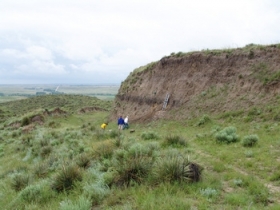Ancient soils found to contain significant amounts of carbon

Soils that formed on Earth's surface thousands of years ago and that are now deeply buried features of vanished landscapes have been found to be rich in carbon, adding a new dimension to our planet's carbon cycle.
The finding, reported in the journal Nature Geoscience, is significant as it suggests that deep soils can contain long-buried stocks of organic carbon which could, through erosion, agriculture, deforestation, mining and other human activities, contribute to global climate change.
"There is a lot of carbon at depths where nobody is measuring," says Erika Marin-Spiotta, a University of Wisconsin-Madison assistant professor of geography and the lead author of the new study. "It was assumed that there was little carbon in deeper soils. Most studies are done in only the top 30 centimeters. Our study is showing that we are potentially grossly underestimating carbon in soils."
The soil studied by Marin-Spiotta and her colleagues, known as the Brady soil, formed between 15,000 and 13,500 years ago in what is now Nebraska, Kansas and other parts of the Great Plains. It lies up to six-and-a- half meters below the present-day surface and was buried by a vast accumulation of windborne dust known as loess beginning about 10,000 years ago, when the glaciers that covered much of North America began to retreat.
The region where the Brady soil formed was not glaciated, but underwent radical change as the Northern Hemisphere's retreating glaciers sparked an abrupt shift in climate, including changes in vegetation and a regime of wildfire that contributed to carbon sequestration as the soil was rapidly buried by accumulating loess.
Photo shows an eroding bluff on the Great Plains revealing a buried, carbon-rich layer of fossil soil — which could contribute to climate change, according to new research. (Photo : Joseph Mason/ University of Wisconsin-Madison )
Read more at ScienceDaily.
2014©. Copyright Environmental News Network